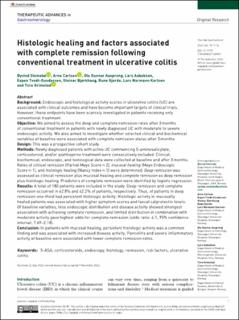| dc.contributor.author | Steinsbø, Øyvind | |
| dc.contributor.author | Carlsen, Arne | |
| dc.contributor.author | Aasprong, Ole Gunnar | |
| dc.contributor.author | Aabakken, Lars | |
| dc.contributor.author | Tvedt-Gundersen, Espen | |
| dc.contributor.author | Bjørkhaug, Steinar Traae | |
| dc.contributor.author | Gjerde, Rune | |
| dc.contributor.author | Karlsen, Lars Normann | |
| dc.contributor.author | Grimstad, Tore Bjørn | |
| dc.date.accessioned | 2023-01-24T10:18:57Z | |
| dc.date.available | 2023-01-24T10:18:57Z | |
| dc.date.created | 2022-12-25T11:01:23Z | |
| dc.date.issued | 2022 | |
| dc.identifier.issn | 1756-283X | |
| dc.identifier.uri | https://hdl.handle.net/11250/3045770 | |
| dc.description.abstract | Background:
Endoscopic and histological activity scores in ulcerative colitis (UC) are associated with clinical outcomes and have become important targets of clinical trials. However, these endpoints have been scarcely investigated in patients receiving only conventional treatment.
Objective:
We aimed to assess the deep and complete remission rates after 3 months of conventional treatment in patients with newly diagnosed UC with moderate to severe endoscopic activity. We also aimed to investigate whether selected clinical and biochemical variables at baseline were associated with complete remission status after 3 months.
Design:
This was a prospective cohort study.
Methods:
Newly diagnosed patients with active UC commencing 5-aminosalicylate, corticosteroid, and/or azathioprine treatment were consecutively included. Clinical, biochemical, endoscopic, and histological data were collected at baseline and after 3 months. Rates of clinical remission (Partial Mayo Score ⩽ 2), mucosal healing (Mayo Endoscopic Score ⩽ 1), and histologic healing (Nancy Index ⩽ 1) were determined. Deep remission was assessed as clinical remission plus mucosal healing and complete remission as deep remission plus histologic healing. Predictors of complete remission were identified by logistic regression.
Results:
A total of 180 patients were included in the study. Deep remission and complete remission occurred in 62.8% and 42.2% of patients, respectively. Thus, of patients in deep remission one-third had persistent histologic activity. Histologic activity in mucosally healed patients was associated with higher symptom scores and faecal calprotectin levels. Of baseline variables, less endoscopic distribution and disease activity showed strongest association with achieving complete remission, and limited distribution in combination with moderate activity gave highest odds for complete remission (odds ratio: 4.1, 95% confidence interval: 7.69–2.18).
Conclusion:
In patients with mucosal healing, persistent histologic activity was a common finding and was associated with increased disease activity. Pancolitis and severe inflammatory activity at baseline were associated with lower complete remission rates. | en_US |
| dc.language.iso | eng | en_US |
| dc.publisher | SAGE Publications | en_US |
| dc.rights | Navngivelse 4.0 Internasjonal | * |
| dc.rights.uri | http://creativecommons.org/licenses/by/4.0/deed.no | * |
| dc.title | Histologic healing and factors associated with complete remission following conventional treatment in ulcerative colitis | en_US |
| dc.type | Journal article | en_US |
| dc.type | Peer reviewed | en_US |
| dc.description.version | publishedVersion | en_US |
| dc.rights.holder | Copyright The Author(s) 2022 | en_US |
| cristin.ispublished | true | |
| cristin.fulltext | original | |
| cristin.qualitycode | 1 | |
| dc.identifier.doi | 10.1177/17562848221140659 | |
| dc.identifier.cristin | 2097352 | |
| dc.source.journal | Therapeutic Advances in Gastroenterology | en_US |
| dc.source.pagenumber | 1-14 | en_US |
| dc.identifier.citation | Therapeutic Advances in Gastroenterology. 2022, 15, 1-14. | en_US |
| dc.source.volume | 15 | en_US |

